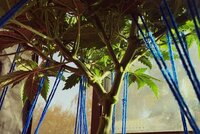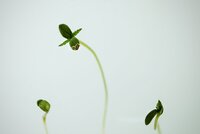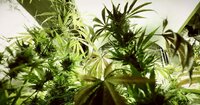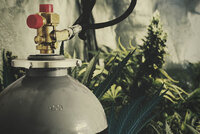- Thread starter
- #161
DrCannaCanadian
Well-Known Member
Learn the main-lining training method to drastically increase your yields. It is surprisingly simple and incredibly effective. Best of all? You won't need to buy anything fancy.
Main-lining is a training technique that has gained lots of popularity in recent years. It sometimes also goes by the name “manifolding” or even “fluxing.” The ultimate goal, like with other techniques, is to train your plant into making better use of the grow space, coaxing it into producing higher yields.
When properly executed, main-lining will permit you to grow indoors just like you would with a ScrOG net, only without the net. This is a blessing in tight grow spaces.
In practical terms, main-lining is a mix between LST, topping and a ScrOG net.
The idea behind this training technique is quite ingenious and offers many benefits to the growth pattern and vigor of your plants. The process involves training your seedling into producing a stem that looks like a manifold with a main Y-shaped split; subsequently, you replicate this process on newer growths during the vegetative period. This results in doubling the number of main colas. Theoretically, you can keep doubling these colas for as long as you like, producing as many as 4, 8, 16, 32...

SYMMETRY IS KING
The other benefit of main-lining is controlling apical dominance. In the same way that you can be right or left handed, plants tend to favor the point closer to the light source and invest growth in that shoot. This involves a tight hormonal balance within the plant’s physiology that you can easily manipulate with just a bit of string or wire.
If you see that one shoot is growing at faster rate than the others, instead of topping it to slow it down, you can simply tie it below the height of the next best shoot and the plant will redirect its energy to the secondary main shoot. Keep doing this to create an even canopy.
In this way, you can effectively trick the plant into balancing its energy between the main shoots, producing a beautiful and robust bush.
We suggest starting from seed because one of the key components to a successful main-line is symmetrical, opposite branch-node growth. As plants reach sexual maturity, they may start alternating branch-nodes. It is very common for clones to start alternating quickly after rooting. If your goal is to achieve top performance from main-lining, definitely start from seed.

CREATING THE MANIFOLD
Main-lining is all about symmetry. Starting from seed, you should top the plant after the third internode. This will create a Y-shaped stem right off the bat. Give it a few days to recover, then gently remove all the foliage below.
You will now have two main shoots. Tie them down, gently. Remember, it is all too easy to snap a branch off, so exercise caution. Massage the stem to loosen it up a bit and go slow. Try to bring the two stems down in such a way that it grows out horizontally.
After a short period of growth, you can repeat the process. This will render you with 4 main stems. If you wanted, you could keep going to produce 16, 32 or 64 main colas! But that is not practical at all and will only increase your veg time to a point that it is simply not worth it. Ideally, you should stop topping altogether around week 3.
From here on, there is not much else to do, except for the usual plant tending practices. You will immediately notice how much less work you need to do.

THAT’S ALL, FOLKS
There is nothing more to it, really. Flip them to flower and prepared to be amazed.
The main advantage of this technique is that all the stress is applied very early on in the plant’s life cycle. From here on, you just sit back and relax. When the flowering stretch occurs, there is no longer a need for added stress, such as bending, topping or super-cropping. While these techniques do have their merits, they considerably increase the ripening and harvest times, suddenly forcing the plant to re-program itself and direct energy to other branches.
You will notice with main-lining that you make better use of your lights as canopy distribution is much more even. It is also far less likely that your plants will experience bud rot since this method promotes more efficient airflow.
The occurrence of “popcorn” buds is astonishingly reduced as well. As the early flowering stretch happens, there are no lower branches desperate for light. This means no more of those pesky, long branches that seem to promise a few extra grams, but are just a waste of water, nutrients and light. All that energy will be better concentrated on the stars of the show, the main fat colas and large dense buds surrounding them.
NO NET NEEDED
As mentioned earlier, with main-lining there is no need for a ScrOG net. With this training technique, plants suffer quite a bit early on, tending to overcompensate by engorging the main stems massively. The thicker stems, along with the tie-down training, will make plants look like heavyweight lifting champions. A ScrOG net is used to open up the canopy and serve as support, but it is normal for tops to simply fall over.
With main-lining, this tends not to happen. Branches are not bent over to open up the plant, but shoot straight up and become perfectly balanced. This is a huge plus in the grow room. Now you can walk freely around pots to tend to your plants, without being on all fours and complaining about your back shortly after.

HARVESTING
Last but not least, the joy of harvest. Plants that undergo main-lining become surprisingly easy to trim. The big colas and huge buds will be so dense that a quick snip around the edges will leave you with a top-shelf-worthy manicure. Long gone are the days of frustratingly snipping away leaves to make the best use of all produce. With main-lining, some growers report cutting down trimming time by whopping 75% with some strains.
If it sounds too fantastical to you, it’s because you haven't tried it. It is probably one of the easiest techs in the business and one of the older underground grower's secrets. Just remember the two key points. Use quality seeds and keep the symmetry. You will be astonished by the results.
Main-lining is a training technique that has gained lots of popularity in recent years. It sometimes also goes by the name “manifolding” or even “fluxing.” The ultimate goal, like with other techniques, is to train your plant into making better use of the grow space, coaxing it into producing higher yields.
When properly executed, main-lining will permit you to grow indoors just like you would with a ScrOG net, only without the net. This is a blessing in tight grow spaces.
In practical terms, main-lining is a mix between LST, topping and a ScrOG net.
The idea behind this training technique is quite ingenious and offers many benefits to the growth pattern and vigor of your plants. The process involves training your seedling into producing a stem that looks like a manifold with a main Y-shaped split; subsequently, you replicate this process on newer growths during the vegetative period. This results in doubling the number of main colas. Theoretically, you can keep doubling these colas for as long as you like, producing as many as 4, 8, 16, 32...
The other benefit of main-lining is controlling apical dominance. In the same way that you can be right or left handed, plants tend to favor the point closer to the light source and invest growth in that shoot. This involves a tight hormonal balance within the plant’s physiology that you can easily manipulate with just a bit of string or wire.
If you see that one shoot is growing at faster rate than the others, instead of topping it to slow it down, you can simply tie it below the height of the next best shoot and the plant will redirect its energy to the secondary main shoot. Keep doing this to create an even canopy.
In this way, you can effectively trick the plant into balancing its energy between the main shoots, producing a beautiful and robust bush.
We suggest starting from seed because one of the key components to a successful main-line is symmetrical, opposite branch-node growth. As plants reach sexual maturity, they may start alternating branch-nodes. It is very common for clones to start alternating quickly after rooting. If your goal is to achieve top performance from main-lining, definitely start from seed.
Main-lining is all about symmetry. Starting from seed, you should top the plant after the third internode. This will create a Y-shaped stem right off the bat. Give it a few days to recover, then gently remove all the foliage below.
You will now have two main shoots. Tie them down, gently. Remember, it is all too easy to snap a branch off, so exercise caution. Massage the stem to loosen it up a bit and go slow. Try to bring the two stems down in such a way that it grows out horizontally.
After a short period of growth, you can repeat the process. This will render you with 4 main stems. If you wanted, you could keep going to produce 16, 32 or 64 main colas! But that is not practical at all and will only increase your veg time to a point that it is simply not worth it. Ideally, you should stop topping altogether around week 3.
From here on, there is not much else to do, except for the usual plant tending practices. You will immediately notice how much less work you need to do.
There is nothing more to it, really. Flip them to flower and prepared to be amazed.
The main advantage of this technique is that all the stress is applied very early on in the plant’s life cycle. From here on, you just sit back and relax. When the flowering stretch occurs, there is no longer a need for added stress, such as bending, topping or super-cropping. While these techniques do have their merits, they considerably increase the ripening and harvest times, suddenly forcing the plant to re-program itself and direct energy to other branches.
You will notice with main-lining that you make better use of your lights as canopy distribution is much more even. It is also far less likely that your plants will experience bud rot since this method promotes more efficient airflow.
The occurrence of “popcorn” buds is astonishingly reduced as well. As the early flowering stretch happens, there are no lower branches desperate for light. This means no more of those pesky, long branches that seem to promise a few extra grams, but are just a waste of water, nutrients and light. All that energy will be better concentrated on the stars of the show, the main fat colas and large dense buds surrounding them.
NO NET NEEDED
As mentioned earlier, with main-lining there is no need for a ScrOG net. With this training technique, plants suffer quite a bit early on, tending to overcompensate by engorging the main stems massively. The thicker stems, along with the tie-down training, will make plants look like heavyweight lifting champions. A ScrOG net is used to open up the canopy and serve as support, but it is normal for tops to simply fall over.
With main-lining, this tends not to happen. Branches are not bent over to open up the plant, but shoot straight up and become perfectly balanced. This is a huge plus in the grow room. Now you can walk freely around pots to tend to your plants, without being on all fours and complaining about your back shortly after.
Last but not least, the joy of harvest. Plants that undergo main-lining become surprisingly easy to trim. The big colas and huge buds will be so dense that a quick snip around the edges will leave you with a top-shelf-worthy manicure. Long gone are the days of frustratingly snipping away leaves to make the best use of all produce. With main-lining, some growers report cutting down trimming time by whopping 75% with some strains.
If it sounds too fantastical to you, it’s because you haven't tried it. It is probably one of the easiest techs in the business and one of the older underground grower's secrets. Just remember the two key points. Use quality seeds and keep the symmetry. You will be astonished by the results.













